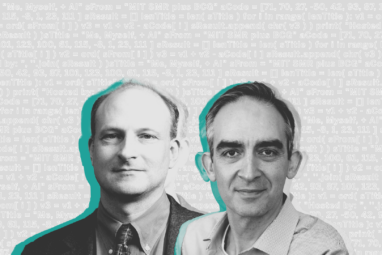The Collective Intelligence Genome
A user’s guide to the building blocks of collective intelligence: By recombining CI “genes” according to the work required, managers can design the powerful system they need.
Topics
Social Business
Google. Wikipedia. Threadless. All are exemplars of collective intelligence in action. Two of them are famous. The third is getting there.
Each of the three helps demonstrate how large, loosely organized groups of people can work together electronically in surprisingly effective ways — sometimes even without knowing that they are working together, as in the case of Google. Google takes the judgments made by millions of people as they create links to web pages and harnesses that collective knowledge of the entire web to produce amazingly intelligent answers to the questions we type into the Google search bar.
In Wikipedia, thousands of contributors from across the world have collectively created the world’s largest encyclopedia, with articles of remarkably high quality. Wikipedia has been developed with almost no centralized control. Anyone who wants to can change almost anything, and decisions about what changes to keep are made by a loose consensus of those who care. What’s more, the people who do all this work don’t even get paid; they’re volunteers.
The Leading Question
How can you get crowds to do what your business needs done?
Findings
- Collective intelligence has already been proven to work, and CI systems can be designed and managed to fit specific needs.
- CI building blocks, or “genes,” can be recombined to create the right kind of system.
- Four main questions drive CI “genome” design: What is being done? Who is doing it? Why? How?
In Threadless, anyone who wants to can design a T-shirt, submit that design to a weekly contest and then rate their favorite designs. From the entries receiving the highest ratings, the company selects winning designs, puts them into production and gives prizes and royalties to the winning designers. In this way, the company harnesses the collective intelligence of a community of over 500,000 people to design and select T-shirts.
These examples of web-enabled collective intelligence are inspiring to read about.1 More than inspiring, even; they’ve come to look like management wish fulfillment — evidence that a committed embrace of collective intelligence is all it takes for a company to magically divine market desires, create exactly what’s needed to satisfy them and do it all at little or no cost. Come let the crowd get your work done for you — cheap, perfect and now.
References (6)
1. T.W. Malone, “The Future of Work” (Boston: Harvard Business School Press, 2004); J. Howe, “Crowdsourcing” (New York: Crown Business, 2008); J. Surowiecki, “The Wisdom of Crowds” (New York: Doubleday, 2004); Y. Benkler, “The Wealth of Networks” (New Haven: Yale University Press, 2006); and D. Tapscott and A.D. Williams, “Wikinomics” (New York: Penguin, 2006).
2. A. Kates and J.R. Galbraith, “Designing Your Organization” (San Francisco: Jossey-Bass, 2007).





Comments (4)
S.H.O.E.S. | Consumer Channel Dynamics
Kathleen McAuliffe
Teri VanHall
Jack D. Pond